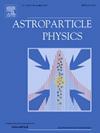Crystal Eye: All sky MeV monitor with high precision real-time localization
IF 2.9
3区 物理与天体物理
Q1 ASTRONOMY & ASTROPHYSICS
引用次数: 0
Abstract
Crystal Eye is a space-based all-sky monitor optimized for the autonomous detection and localization of transients in the 10 keV to 30 MeV energy range, a region where extensive observations and monitoring of various astrophysical phenomena are required. By focusing on the operating environment and its impact on the observation process, we optimized the detector design and assessed its scientific potential. We explored the use of novel techniques to achieve the science goals of the experiment. We assumed the orbit of a potential future mission at approximately 550 km altitude near the equatorial region with a 20° inclination. In such an orbit, the main background contributions for this kind of detector are from different particles and radiation of cosmic origin and secondaries produced by their interaction in the Earth’s atmospheric and geomagnetic environment. We studied the response of Crystal Eye detector in this background environment, using the Geant4 Monte Carlo simulation toolkit. We also calculated other detector performance parameters to estimate its scientific capabilities. The effective area and efficiency of the detector are calculated for low energy -ray sources and used to estimate its sensitivity to short-duration transient sources. The calculation shows a better effective area and sensitivity by several factors compared to existing instruments of similar type. A method is also developed and discussed to estimate the online transient-localization performance of the detector, suggesting a better localization precision by about an order of magnitude than those typically reported by existing -ray monitors. We present here the simulation study and results of an innovative detector design concept that can make a significant contribution in the multi-messenger era. Moreover, this study can be useful as a technical reference for similar future experiments.
水晶眼:高精度实时定位的全天空MeV监视器
“水晶之眼”是一种天基全天候监测仪,针对10 keV至30 MeV能量范围内瞬态的自主探测和定位进行了优化,该区域需要对各种天体物理现象进行广泛的观测和监测。通过关注操作环境及其对观测过程的影响,我们优化了探测器的设计并评估了其科学潜力。我们探索使用新技术来实现实验的科学目标。我们假设一个潜在的未来任务的轨道在赤道附近大约550公里的高度,倾角为20°。在这样的轨道上,这种探测器的主要背景贡献来自不同的粒子和宇宙起源的辐射,以及它们在地球大气和地磁环境中相互作用产生的次级辐射。我们使用Geant4蒙特卡罗仿真工具包研究了水晶眼探测器在这种背景环境下的响应。我们还计算了探测器的其他性能参数,以估计其科学能力。计算了探测器对低能量γ射线源的有效面积和效率,并用于估计其对短持续时间瞬态源的灵敏度。计算结果表明,与现有同类仪器相比,该仪器具有更好的有效面积和灵敏度。本文还提出并讨论了一种估计探测器在线瞬态定位性能的方法,表明其定位精度比现有γ射线监测仪的定位精度高一个数量级。我们在这里提出了一种创新的探测器设计概念的仿真研究和结果,可以在多信使时代做出重大贡献。此外,本研究可为今后类似实验提供技术参考。
本文章由计算机程序翻译,如有差异,请以英文原文为准。
求助全文
约1分钟内获得全文
求助全文
来源期刊

Astroparticle Physics
地学天文-天文与天体物理
CiteScore
8.00
自引率
2.90%
发文量
41
审稿时长
79 days
期刊介绍:
Astroparticle Physics publishes experimental and theoretical research papers in the interacting fields of Cosmic Ray Physics, Astronomy and Astrophysics, Cosmology and Particle Physics focusing on new developments in the following areas: High-energy cosmic-ray physics and astrophysics; Particle cosmology; Particle astrophysics; Related astrophysics: supernova, AGN, cosmic abundances, dark matter etc.; Gravitational waves; High-energy, VHE and UHE gamma-ray astronomy; High- and low-energy neutrino astronomy; Instrumentation and detector developments related to the above-mentioned fields.
 求助内容:
求助内容: 应助结果提醒方式:
应助结果提醒方式:


